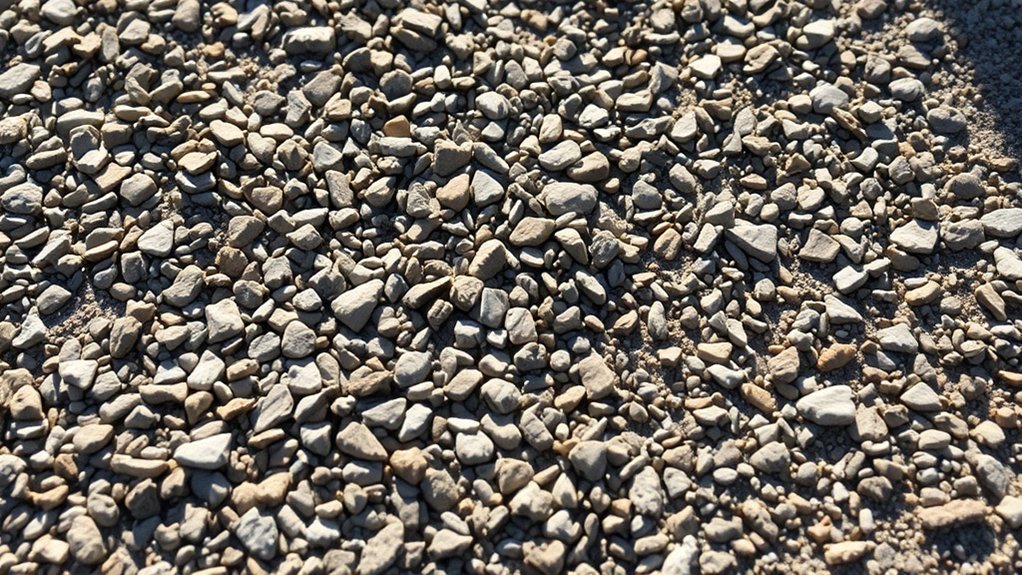Certain colours of resin-bound gravel can enhance slip resistance due to their effect on visibility and texture. High-contrast colours improve surface awareness, making it easier to judge footing. Lighter aggregates reflect more light, increasing safety in low-light conditions, while coarser textures help break surface water, enhancing grip. Using a mix of aggregate sizes can also increase surface roughness, promoting better traction. Understanding these factors can reveal how colour contributes to safety in resin-bound surfaces.
Key Takeaways
- High-contrast colours enhance the visibility of the surface texture, allowing for better assessment of footing and reducing the risk of slips.
- Lighter aggregates are particularly useful in low-light conditions, helping users spot potential slip hazards.
- Blended colour mixes draw attention to uneven surfaces, prompting users to take more care and thereby reducing the likelihood of slipping.
- Coarse, irregular aggregate textures create small ridges that improve grip by enhancing mechanical interlocking, making the surface more slip-resistant.
- Angular aggregates interlock effectively and provide better traction, contributing to the slip-resistant properties of certain colours.
Understanding Resin-Bound vs. Resin-Bonded Gravel
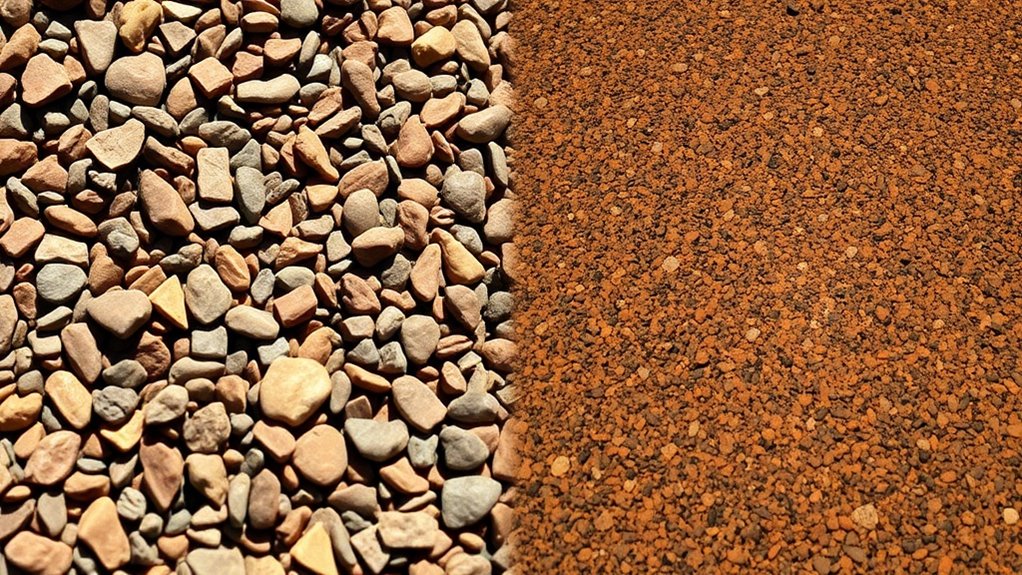
When choosing between resin-bound and resin-bonded gravel, it’s important to grasp their key differences.
Resin-bound gravel is created by mixing aggregates with resin before it’s laid, resulting in a smooth, permeable surface. On the other hand, resin-bonded gravel involves applying resin to the base first, then scattering loose aggregates on top, which creates a textured, non-permeable finish. This difference in composition significantly impacts durability and maintenance. Resin-bound surfaces tend to last longer and need less upkeep due to their solid structure, while resin-bonded surfaces can experience stone loss over time. Additionally, resin bonded surfaces require careful planning for drainage to prevent flooding issues. Moreover, heavy vehicles can accelerate surface wear and lead to premature cracks in resin-bound gravel installations.
The application methods also vary; resin-bound installations require specialist skills and curing, making them less DIY-friendly, whereas resin-bonded options are often more accessible for home projects.
The Role of Aggregate Color in Slip Resistance
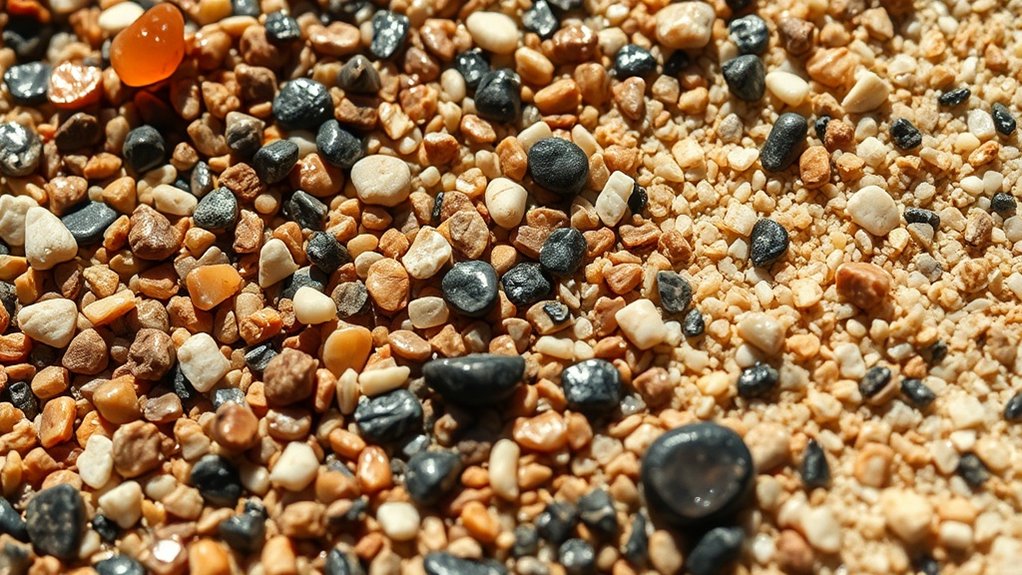
Here are a few key points to consider:
- High contrast colours improve the visibility of surface texture, making it easier to gauge footing conditions.
- Lighter aggregates reflect light, enhancing safety in dimly lit areas, whereas darker colours can mask texture details. Additionally, the non-slip finish of resin-bound gravel ensures that users can maintain their footing even in wet conditions.
- Mixed colour blends add visual complexity, drawing attention to uneven surfaces and encouraging caution. Additionally, the durable, porous surface system of resin-bound gravel contributes to overall safety by providing a slip-resistant texture.
Material Properties That Enhance Grip
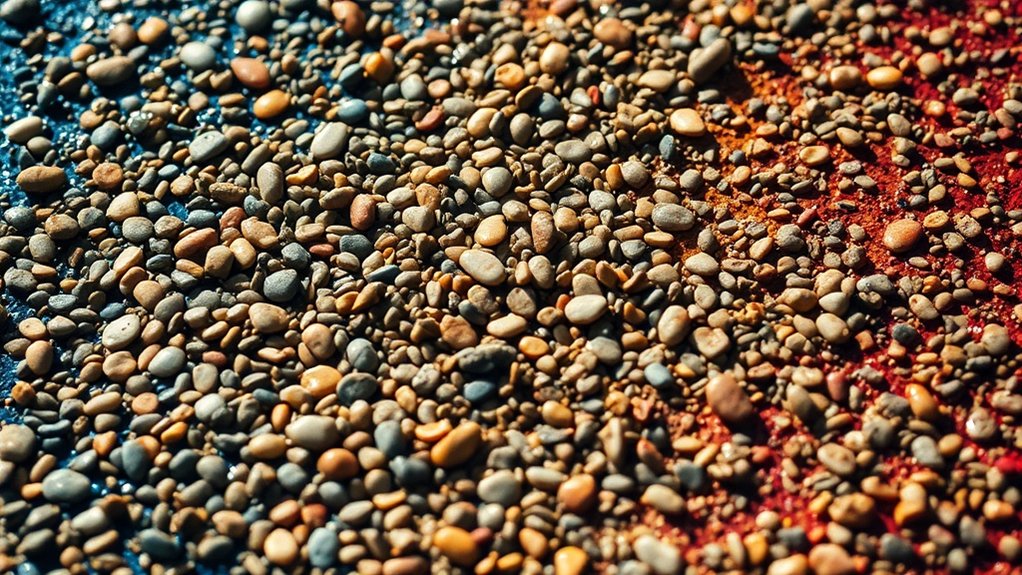
When choosing materials for slip-resistant surfaces, it’s essential to consider how the shape, hardness, and texture of aggregates affect grip. Angular aggregates are generally more effective as they interlock better, providing greater stability underfoot. Moreover, a tough surface texture retains its slip-resistant qualities over time, which is crucial for safety. For instance, using rough-textured finishes in wet areas like bathrooms or kitchens can significantly reduce the risk of slips. The Resin Bound UVR Pro’s anti-slip properties demonstrate that certain resin-bound gravel colors can enhance traction even further, especially when anti-slip additives are incorporated during installation.
Aggregate Shape Influence
Aggregate shape is crucial for enhancing slip resistance, as the combination of angularity, sphericity, and texture significantly impacts surface grip.
It’s important to understand how aggregate angularity affects performance. Sharper, more angular aggregates offer better mechanical interlock with resin, which in turn improves slip resistance.
Here are the key characteristics to consider:
- Angular aggregates provide better grip due to their sharp edges and interlocking ability.
- Rough surface textures increase microtexture, enhancing traction, particularly in wet conditions.
- Higher sphericity is linked to lower slip resistance, while irregular shapes enhance inter-particle roughness.
Conducting a shape stability analysis ensures that chosen aggregates retain their advantageous properties over time, optimising slip resistance in resin-bound applications.
Hardness and Durability
Understanding the hardness and durability of resin-bound gravel is crucial for ensuring proper slip resistance in various applications. Factors like resin quality and aggregate density directly affect the surface grip.
During durability tests, materials must show resilience against wear from heavy traffic and environmental conditions. High-quality resin improves both hardness and durability, maintaining consistent slip resistance over time.
Additionally, properties like elastic modulus and compressive strength help the surface retain its structure and friction under stress. By choosing materials that excel in these areas, you can create a reliable, slip-resistant surface that performs well throughout its lifespan.
Surface Texture Importance
Surface texture is crucial for improving grip on resin-bound gravel surfaces. The combination of aggregate shape and texture is key for enhancing traction.
Here are some important factors to consider:
- Coarser, irregular aggregates create micro-textures that improve mechanical interlocking with footwear, making it less likely to slip.
- A mix of aggregate sizes fills in gaps, which reduces smoothness and increases overall surface roughness, providing better footing.
- Ensuring adequate exposure of aggregates in the resin allows for maximum texture visibility, significantly enhancing slip resistance.
Impact of Porosity on Surface Safety
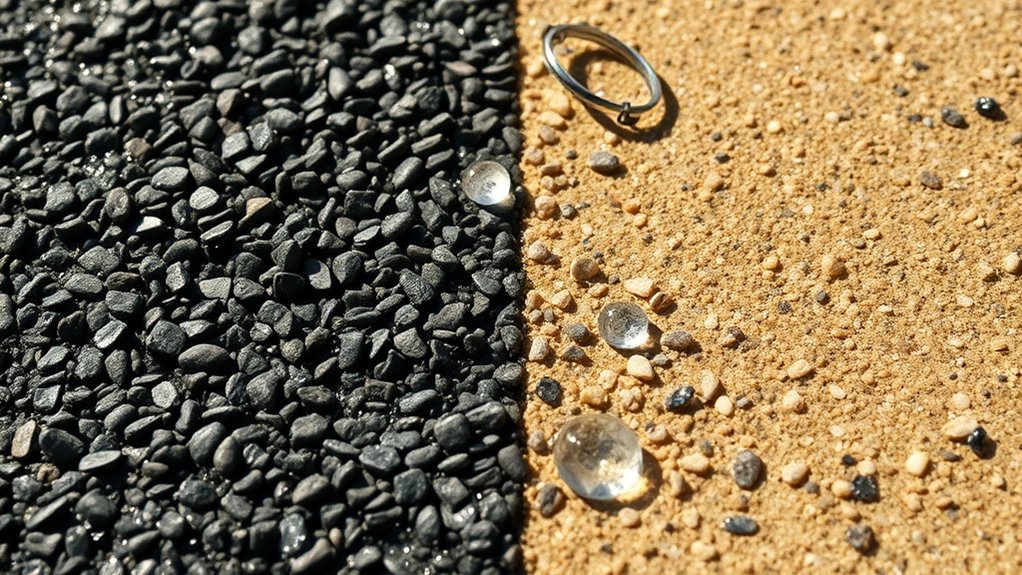
Porosity significantly affects surface safety by improving slip resistance. Resin-bound gravel, for instance, offers excellent porosity, allowing water to drain efficiently. This prevents water accumulation, which can create slippery conditions.
By letting water filter through, porous surfaces reduce the risk of hydroplaning and the formation of black ice.
Additionally, the right aggregate sizing enhances porosity, ensuring a good balance between water permeability and surface grip. This structured porosity helps prevent the growth of slippery substances like algae and mitigates extreme temperature effects, further enhancing safety.
In short, maintaining proper porosity is essential to keeping surfaces safe and functional, regardless of the weather.
Maintenance Practices for Optimal Slip Resistance
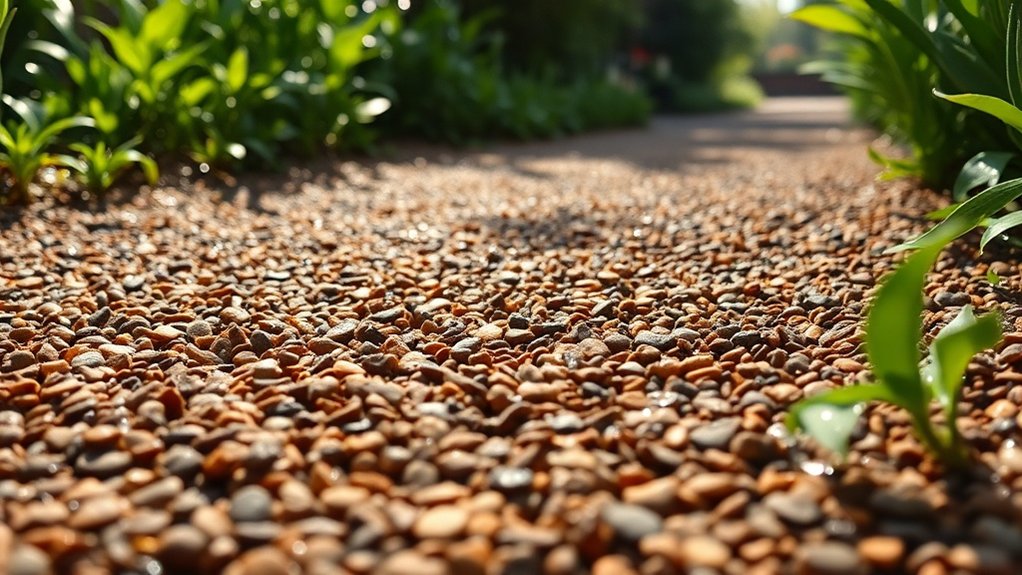
To maintain optimal slip resistance on resin-bound gravel surfaces, regular maintenance is crucial for safety and functionality.
Here are some straightforward practices to follow:
- Regular Sweeping: Sweep away leaves and debris to keep the surface clear and prevent slip hazards.
- Gentle Washing: Use a low-pressure washer to clean off dirt and grime without harming the resin or aggregate.
- Proper Drainage: Make sure drainage systems are effective to avoid water pooling, which can create slippery spots.
Design Considerations for Enhanced Traction
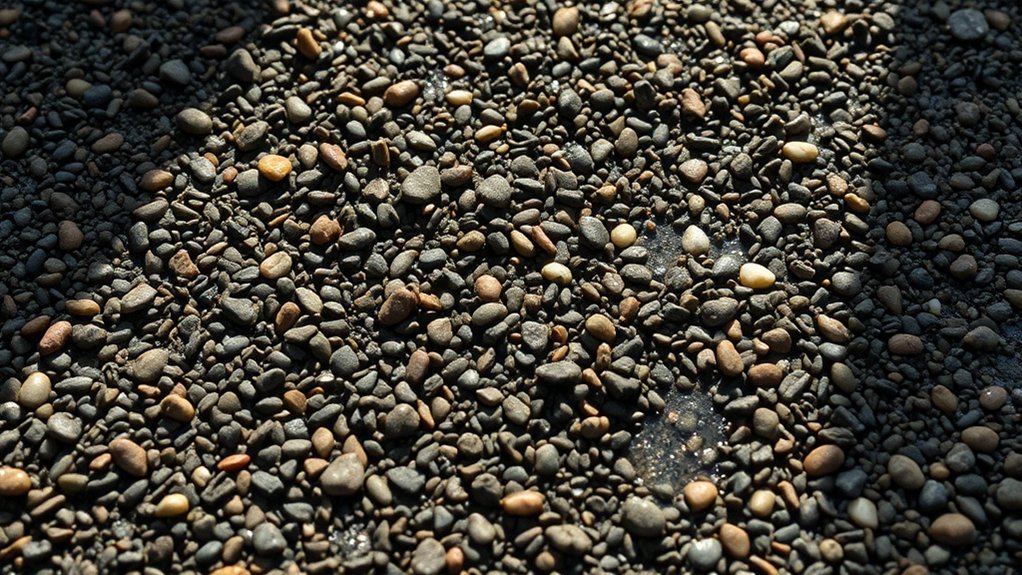
When designing for improved traction, it’s important to consider the texture of the aggregates as it directly affects grip.
The colour of the aggregates also matters; it influences both visibility and slip resistance in different conditions.
Additionally, ensuring proper installation techniques is crucial to maintain the surface’s safety features over time.
For instance, a textured surface with light-coloured aggregates can enhance visibility in wet weather, making it safer for pedestrians.
Aggregate Texture Importance
The texture of aggregate is crucial for improving traction and slip resistance in pavement applications. When assessing aggregate classification, it’s essential to consider texture for optimal performance.
Key aspects include:
- Micro-texture: This creates tiny surface irregularities that help break water films, enhancing tyre grip.
- Macro-texture: A rougher surface increases friction by deforming tyres, which boosts grip.
- Aggregate Shape: Angular and irregular particles interlock better and provide superior skid resistance compared to smooth, rounded aggregates.
Evaluating texture ensures that selected aggregates maintain their grip in dynamic conditions, reducing wear and preserving slip resistance.
Choosing the right texture not only enhances safety but also extends the lifespan of the pavement, making it a vital consideration in the design of resin-bound systems.
Color Impact on Traction
The impact of colour on traction is significant and shouldn’t be overlooked. Darker colours tend to absorb heat, which can affect the flexibility of the resin and its micro-texture, potentially leading to reduced slip resistance.
On the other hand, lighter colours reflect heat, helping to maintain a consistent surface temperature that supports traction in various weather conditions. Mid-tone colours offer a balance by reducing glare while still allowing for good visibility of the texture.
High-contrast colours improve visibility, helping pedestrians to better identify surface irregularities and lowering the risk of slips. Furthermore, using UV-stable pigments ensures that colours remain vibrant and functional over time, which helps maintain slip resistance.
Installation Techniques for Safety
To ensure safety and improve traction during installation, it’s crucial to use techniques suited to the specific site conditions.
Following safety standards and effective methods will result in a durable, slip-resistant surface. Here are some important considerations:
- Check the ground temperature and humidity to achieve optimal resin curing.
- Use angular aggregates and add anti-slip materials like crushed glass to enhance grip.
- Ensure a minimum depth of 18mm, particularly on slopes, for greater durability.
Long-Term Performance of Colored Resin-Bound Surfaces
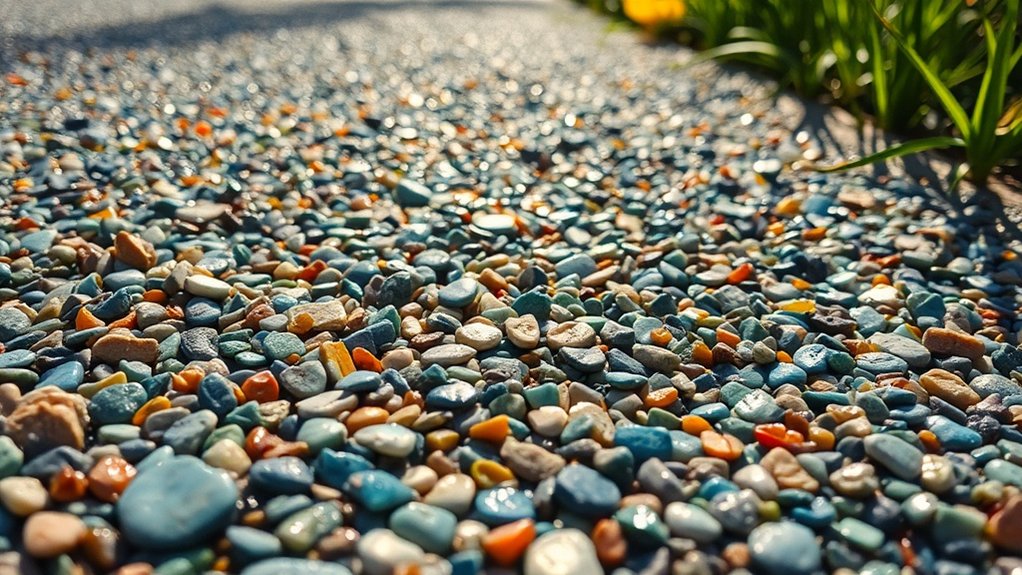
When assessing the long-term performance of coloured resin-bound surfaces, it’s important to note their durability and capacity to endure environmental challenges. These surfaces are known for their impressive longevity and resistance to wear, while also maintaining slip resistance.
| Factor | Impact on Performance |
|---|---|
| UV Resistance | Prevents colour fading |
| Aggregate Hardness | Enhances durability and grip |
| Maintenance Frequency | Minimises moss and algae growth |
Regular upkeep, such as power washing, helps maintain both the appearance and traction of the surface. Incorporating textured aggregates and anti-slip additives can further enhance grip, ensuring safety in various conditions. In summary, when installed and maintained properly, resin-bound surfaces deliver consistent performance over time, making them a dependable option for outdoor settings.
Frequently Asked Questions
Do Certain Colors Fade Faster Than Others in Resin-Bound Gravel?
Yes, certain colours do fade faster in resin-bound gravel. Lighter shades tend to have less pigment stability, while darker colours generally hold their colour better. For example, a pale grey may lose its vibrancy quicker than a deep blue, as darker hues can absorb UV rays more effectively, enhancing their durability.
How Does Temperature Affect the Slip Resistance of Different Colors?
Temperature variations significantly impact slip resistance. Cooler surfaces tend to hold moisture for longer periods, whereas warmer ones dry out more quickly. Darker colours can soften when heated, which may slightly affect grip. However, with proper installation, these effects can be minimised, ensuring reliable performance across different colours.
Can the Color of Resin Affect Its UV Stability?
Yes, the colour of resin significantly impacts its UV stability. Darker shades tend to absorb more UV radiation, which can affect the stability and degradation rates of colour pigments. For instance, a deep blue resin may fade faster in sunlight than a lighter shade. Using the right formulation and incorporating UV stabilisers can improve resistance, helping to maintain both longevity and appearance.
Are There Specific Color Trends for High-Traffic Areas?
When selecting colours for high-traffic areas, opt for neutral tones and earthy shades. These choices integrate well with the wear and tear of busy spaces, striking a balance between aesthetics and practicality. For instance, soft greys or warm beiges not only hide scuff marks but also create a welcoming atmosphere, making them ideal for hallways and living rooms.
Does the Finish Type Influence Color Perception in Resin-Bound Gravel?
Yes, the finish texture significantly affects colour perception in resin-bound gravel. Glossy finishes accentuate colour contrasts, making patterns and hues more vibrant. In contrast, matte finishes create a softer look, resulting in a more subtle and harmonious appearance across different aggregates. For instance, a glossy finish on a bright red gravel can make it pop, while a matte finish may give it a more understated elegance.
Conclusion
In summary, selecting the right colour of resin-bound gravel is not just about looks; it’s crucial for safety. Picture walking on a bright pathway that enhances your garden while offering reliable grip, even when it’s wet. By considering the colour of the aggregate, the properties of the materials, and their porosity, you can ensure your surfaces remain slip-resistant. Focusing on these aspects guarantees long-lasting performance, allowing you to enjoy your outdoor spaces with confidence.
